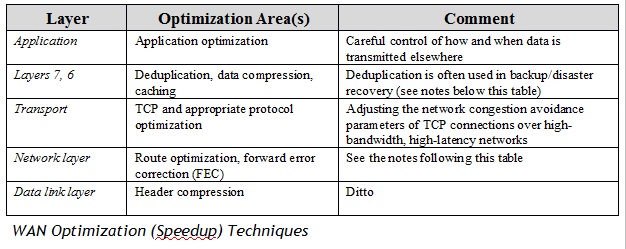Much emphasis is placed on servers and storage when discussing Application Performance, mainly because the application lives on a server and uses storage. However, the network has considerable importance, certainly in the case of WANs where there are ways of speeding up the transmission of data of a network. These techniques usually go under the title WAN Acceleration or WAN Optimization.
It is often thought that the limiting factor in speed of network transmission is the bandwidth of the medium involved but this is not strictly true. There are techniques for getting better performance from WANs, often by biasing data transmission priorities towards more important business processes. Having designed the WAN network and its components, is that it then? Job done?
Not really, since there are tricks you can employ to enhance performance but that is a bonus not a panacea for poor design. There are ways to get apparent extra bandwidth without a disruptive upgrade.
The normal definition is the optimization of available bandwidth in the areas:
■ Don't send what you don't need to send, especially large files or print loads
■ If it must be sent, try to schedule it appropriately so as not to interfere with critical workloads. Use business prioritization as the decision yardstick
■ Use techniques to optimize use of the available bandwidth (discussed below).
1. Caching
This is the storage of data transmitted from a source to a destination at that destination. If the same data is requested at the destination, the optimization software recognizes this and stops any request to the original source for a retransmission.
2. Deduplication
Data deduplication is the replacement of multiple copies or blocks of data (at various levels of granularity) with references to a shared copy in order to save storage space and/or bandwidth (SNIA Definition). Data deduplication can operate at the file, block or bit level.
3. Compression
This is fairly obvious and the data transmission is reduced by an amount dictated by the efficiency of the data compression/decompression algorithms used. The efficiency of a compression technique is measured by the ratio original size of data to the compressed size.
4. FEC (Forward Error Correction)
A “receiver makes it right” transmission technique where extra bits are added to a packet/message for analysis at the receiving end. In general, it means that the receiving end of the transmission is able to detect, and in most cases correct, any erroneous transmissions.
Packets warranting retransmission may:
■ be corrupted due to errors, for example noise
■ lost in link or host failures
■ dropped due to buffer overflow
■ dropped due to aging or sell by date exceeded, for example the TTL (Time To Live) field in IP (Internet Protocol)
5. Traffic shaping
Traffic shaping is the practice of regulating network data transfer to assure a certain level of performance, quality of service (QoS). The practice involves favoring transmission of data from higher priority applications over lesser ones, as designated by the business organization. It is sometimes called packet shaping.
6. Congestion Control
This TCP function is designed to stop the sender shipping more data than the network can handle, as if trying to drink from a fire hose. TCP uses a number of mechanisms based on a parameter called the congestion window.
7. Protocol acceleration
A class of techniques for improving application performance by avoiding or circumventing shortcomings of various protocols. There are several forms of protocol acceleration:
■ TCP Acceleration
■ CIFS (Common Internet File Systems) and NFS (Network File System) Acceleration
■ HTTP (Hypertext Transfer Protocol) Acceleration
■ Microsoft Exchange Acceleration
See reference 7 below, under "WAN Optimization References" which presents good coverage of some of the factors listed above.
8. Transmission protocol
Choose your transmission protocol according to what you are transmitting. Some protocols are better than other at transmitting certain types of data. This will also dictate the expected loss (and hence retransmission) rate
9. Take advice
Take advice from outside if you aren't sure what you are doing.
10. Tricks of the trade
Some of the tricks of the optimization trade are:

Dr. Terry Critchley is the Author of "Making It in IT", "High Performance IT Services" and “High Availability IT Services”.
This blog was created from extracts from Terry Critchley's book: High Performance IT Services [ August 25 2016]
WAN Optimization References
There are a number of useful references on this topic. I found all the following ones useful in various areas as well as being quite easy to follow. I have therefore decided to list them all and let the network experts among you choose your own favorite.
1. WAN Optimization Part 1: TCP Limitations
2. WAN Optimization Part 2: Put Performance Second
3. WAN Optimization Part 3: Overcoming Bandwidth Limitations
4. The 2014 Application & Service Delivery Handbook. Part1: Introduction and Challenges
[Search on “Application and Service Delivery Handbook” to find versions from 2011, 2012 and 2013. Add the search term “webtorials” if the hit list is too large.]


